Ever walked out of a store wondering why you bought something you didn’t plan for? Or clicked “Add to Cart” at midnight just because it felt good? You’re not alone. Impulse spending affects millions of people and plays right into the way our brains are wired. But the good news?
You can learn how to stop impulse buying with a few practical strategies—and a bit of self-awareness. In this blog, we’ll unpack the psychology behind these spontaneous purchases and show you proven techniques to regain control of your spending without guilt or stress.
Why Impulse Buying Happens: A Look Into the Brain
Impulse buying isn’t just a bad habit—it’s a behavioral response rooted in psychology. At its core, it’s driven by instant gratification. When we buy something on impulse, our brain releases dopamine, the “feel good” chemical. This reward loop reinforces the behavior, making us more likely to repeat it.
Environmental triggers like store layout, sale banners, or limited-time offers amplify this response. Online, algorithms feed us exactly what we didn’t know we needed, nudging us to click and spend. That’s why learning how to stop impulse buying means first recognizing what drives it.
Emotional Spending: When Moods Dictate Your Wallet
One of the biggest reasons people fall into impulse spending is emotion. Whether it’s stress, boredom, sadness, or even celebration, our emotions often guide our purchasing decisions.
If you’ve had a rough day, the temporary boost from a new outfit or gadget can feel like a quick fix. But that relief doesn’t last. Understanding this cycle is essential to learning how to stop impulse buying. Start by identifying your emotional triggers. Do you tend to shop when you’re lonely? Angry? Anxious?
Once you know what you’re trying to soothe, you can address the root cause—without swiping your card. Understanding how to stop impulse buying is the first step toward building long-term financial peace. Learn how your emotions affect your budget by exploring the mindset category at Finance Finest.

The Role of Social Media and FOMO
You’re scrolling Instagram, and there it is—another influencer raving about a must-have product. It’s discounted. It’s trending. And now it’s in your cart. Sound familiar?
Social media thrives on curated perfection and peer comparison. That “fear of missing out” (FOMO) drives us to spend so we can keep up. But these purchases often have no real value to us, long-term.
If you’re serious about understanding how to stop impulse buying, it’s time to take control of your digital triggers:
- Unfollow or mute accounts that push constant product promotions.
- Avoid browsing e-commerce apps when bored.
- Use browser extensions that block impulse-purchase triggers.
Retail Therapy or Budget Breakdown?
The phrase “retail therapy” sounds harmless, even cute. But it masks the financial strain impulse spending can cause.
A “quick pick-me-up” can snowball into a maxed-out credit card or drained savings. The more we normalize spending as a coping tool, the harder it becomes to manage our money wisely.
Instead of using shopping as a band-aid, create healthier feel-good alternatives:
- Take a walk
- Listen to a playlist
- Journal your thoughts
- Call a friend
Being intentional with self-care is a foundational part of learning how to stop impulse buying.
The Invisible Cost of Impulse Purchases
It’s not just the price tag. Impulse spending often has hidden consequences:
- Guilt and buyer’s remorse
- Clutter and disorganization
- Missed financial goals
- Relationship tension
When you calculate the emotional toll, it becomes clear that each swipe isn’t just a purchase—it’s a trade-off. By understanding these deeper costs, you can better prioritize long-term value over short-term gratification. Want to build a smarter budget? Browse Finance Finest’s budgeting section. Part of learning how to stop impulse buying is tracking where your money silently disappears, and Rocket Money does exactly that by identifying and canceling wasteful subscriptions.
How Marketers Exploit Your Brain
Ever wonder why checkout counters are packed with tiny, cheap items? Or why “Only 2 left in stock!” makes you feel anxious?
These are not coincidences. They’re carefully crafted tactics that play on your decision-making psychology. Terms like “limited offer,” “buy now, pay later,” and “free shipping over $50” are all nudges designed to override your logical thinking.
To resist them, pause before any non-essential purchase. Even a 5-minute delay can weaken the impulse and help you stick to your plan—another great step in mastering how to stop impulse buying.
Proven Tips to Stop Impulse Buying
Ready to take action? Here are some practical, no-fluff strategies to help you stop impulse spending before it starts.
1. Make a 24-Hour Rule
Before buying anything non-essential, wait 24 hours. Most impulse urges disappear once the emotional high fades.
2. Create a Realistic Budget
Budgeting isn’t about restriction; it’s about clarity. Allocate “fun money” so you can enjoy spending—without overdoing it. One of the smartest ways to practice how to stop impulse buying is by using You Need a Budget (YNAB), which gives every dollar a job and helps you spend with purpose.
3. Use Cash or Debit Only
If you’re using credit, it’s easier to overspend. Stick to cash or debit for discretionary expenses to stay grounded. If you’re figuring out how to stop impulse buying without overcomplicating your finances, Nudget offers a clean, intuitive way to stay accountable.
4. Unsubscribe and Unfollow
Remove temptation by unsubscribing from retail emails and unfollowing accounts that push unnecessary spending.
5. Keep a “Want List”
Instead of buying something instantly, write it down. Review the list at the end of the month. Chances are, you won’t even want half of it.

Reframing the Buying Habit
Habits form through repetition. Every time you give in to an impulse, you reinforce that pattern. But habits can be reprogrammed.
Use the “Cue > Craving > Response > Reward” model to analyze your impulses:
- Cue: You see an ad for sneakers.
- Craving: You imagine how stylish you’ll feel.
- Response: You click ‘Buy Now’.
- Reward: You get a dopamine hit from anticipation.
To break the cycle, interrupt it. Replace the Response with a healthier habit. For example, instead of buying, write down what triggered you and take a walk. This reflection is at the heart of understanding how to stop impulse buying. To truly learn how to stop impulse buying, tools like Fabulous can help rewire your habits by promoting intentional routines and daily discipline.
Building Mindful Spending Habits
Mindfulness isn’t just for meditation—it works for money too. Slow down and tune into your thoughts before making a purchase:
- “Do I really need this?”
- “Will I still want this in a week?”
- “What am I feeling right now?”
This pause gives your rational brain time to catch up with your emotional brain.
Mindful spending creates space for intention, not reaction—and that’s how to stop impulse buying in the long run.
When Impulse Buying Becomes a Bigger Problem
Sometimes, impulse spending points to deeper issues like anxiety, depression, or compulsive behavior. If you’re struggling to stop—even when you’re aware of the damage—it might be time to seek help.
Talking to a therapist or financial counselor can uncover the emotional roots and help you create a realistic, supportive action plan.
There’s no shame in needing help. The real strength is recognizing the pattern and choosing to break it. Explore lifestyle section at Finance Finest that support mental wellness.
Your Spending Style: Are You a Rebel or a Rule-Follower?
Understanding your spending personality can help you tailor strategies that work. For example:
- The Rebel resists strict budgets—flexible spending limits may work better.
- The Overthinker gets decision fatigue—create default rules for purchases.
- The Giver overspends on others—set clear giving limits.
There’s no one-size-fits-all method for how to stop impulse buying. Knowing your mindset is half the battle.
Reclaiming Control Over Your Finances
Stopping impulse spending isn’t about perfection. It’s about progress. The goal is to feel empowered by your choices, not ruled by your urges.
Every time you delay a purchase, every time you walk past a sale, every time you ask “why” before “buy”—you’re taking back control. Over time, this becomes your new default, your new normal.
And that is how to stop impulse buying in a way that lasts.

The Power of Saying “No” to the Unnecessary
Impulse buying thrives on immediacy. But confidence grows in the pause. Each purchase is a choice: between momentary satisfaction and long-term peace. When you say “no” to what doesn’t serve you, you’re saying “yes” to your goals, your freedom, your future.
It’s not about depriving yourself. It’s about prioritizing what really matters. Take control of your finances with expert tips and tools from Finance Finest.
